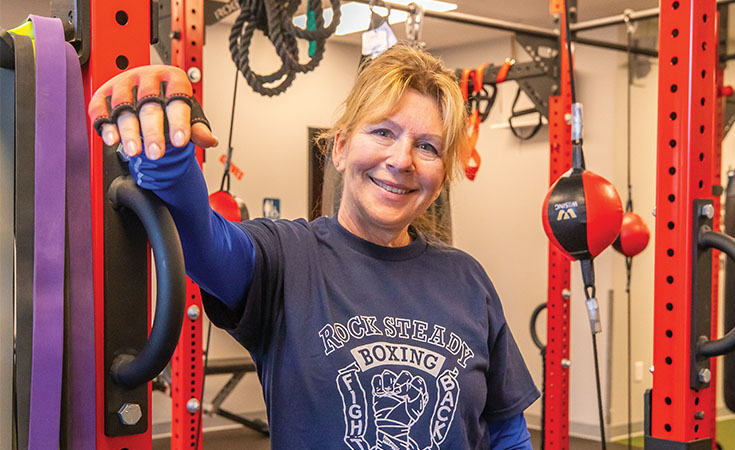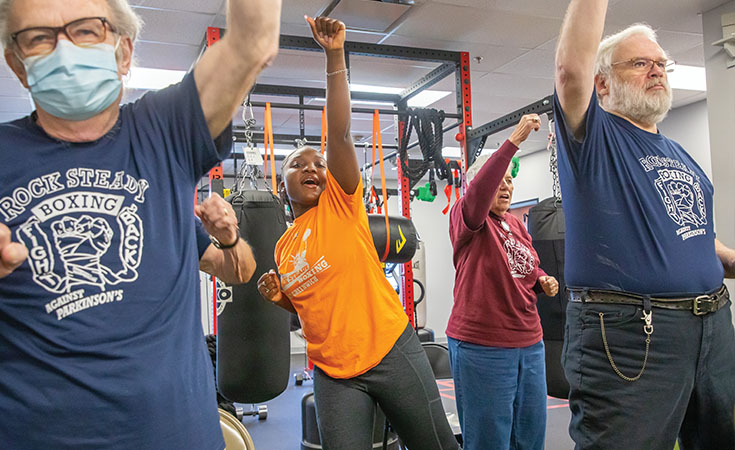Community partnerships enable College of Health & Wellness students to meet their match
It’s just after noontime at Rock Steady Boxing in Rhode Island and dozens of punching bags and mitts hang from the ceiling in tidy rows around the oversized gym.
Phrases on the off-white walls including “Small changes can make a big difference,” “Can’t stop, won’t stop,” and “In this corner, hope,” provide motivation, along with the addictively high-energy music. Today, it’s the Jonas Brothers with the relentless beat of “I’m a Sucker for You.” Two dozen participants in maroon Rock Steady T-shirts follow session leader, Carolyn Kosiba-Quiterio, as she encourages them to count out loud, and she means LOUD.
“One, two, three, four, five,” and on up to “ten!” then all over again; ninety minutes of counting, stretching, leg lifts, using a chair to balance on one leg then the other, followed by sessions with the bags, all with a goal of building body strength.
Geraldine Gibson ’25 OTD, is assisting, a dynamo in a traffic-cone orange T-shirt and black exercise pants, her ponytail flying from side to side. She darts around the room, encouraging the 20-some Parkinson’s clients (called athletes here) and their caregivers, helping steady them, showing how to hit the punching bags as hard as possible, and the best ways to use the mini weights.
Rock Steady Boxing (RSB) is a gym that offers exercise programs for people with Parkinson’s, a neurogenerative disorder with symptoms that include problems with balance, swallowing and gait. Non-contact boxing-inspired routines can dramatically improve the lives of people with Parkinson’s. And while symptoms vary from person to person, boxing can also help with the invisible problems of Parkinson’s lurking below the surface such as sleep and mental health issues, or unregulated blood pressure.
Gibson is working on her doctorate in Occupational Therapy and has already spent 30 hours with this group doing her level 1 field placement. Sessions include strengthening and mindful techniques such as yoga and work-around strategies that participants can take home and use after the sessions. She’ll be back at Rock Steady full time this summer, completing her level ll placement as part of JWU’s College of Health & Wellness’ fieldwork placements. For Gibson, helping these athletes has been inspirational. “I learned you can do anything,” she says. “Not to be a cliché, but don’t be held back, push through.” Gibson also relishes the challenge of graduate work.
Gym owner Kosiba-Quiterio was interested in forming collaborative partnerships with area universities. “It gives those who work with Parkinson’s patients a greater awareness of what it’s like to have the disorder,” she explains. In JWU’s College of Health & Wellness (CHW), students in the Occupational Therapy (OT), Physician Assistant (PA), Master of Public Health and accelerated nursing degree programs receive real-world experience and course credit for placements such as the one at Rock Steady Boxing. For example, CHW students might work alongside the licensed occupational therapists at the Rhode Island Clinic, for uninsured and low-income residents; or at Oasis Recovery & Wellness Center, which serves adults in recovery from mental health and substance use issues.
“The mission of our community placements is to educate the students in a variety of real-life settings, but also to give back,” says Rebecca Simon, Ed.D., CHW’s associate dean. “We want to become a part of the community’s fabric and to give them as much as we gain from them. We want the community to feel that JWU’s College of Health & Wellness is a resource for education, advocacy and support to those who need it.” From the beginning, the emphasis has been on that bilateral relationship, she says. “The end result is betterment of life for those in the community and an exceptional education for our students.” In the three-year OT doctorate program, the first two years are a combination of classroom time and fieldwork, some at community sites and others at more clinical locations such as hospitals. Their third year is all experiential, with rotations in a medical setting or one that’s more nontraditional, like Rock Steady. After three years, students have earned a doctorate, take the final exam and become nationally certified. From there, alumni have gone on to careers in skilled nursing, hospitals and outpatient clinics.
Another example of community outreach is JWU’s partnership with Brown University’s Pathways to Medicine program, where Physician Assistant students mentor local high school students for one semester.
The program introduces the possibility of health science careers to teenagers who might not have considered the field or had exposure to it. It also helps smooth the path as these students transition to college. They form strong bonds with their college-level mentors, receive support as they apply to college, learn about the professional school application process, and strategize pursuit of their healthcare career goals.
Bridget Healy ’24 M.S.P.A.S., is a Pathways to Medicine representative who attends the program’s classes with its participating high school students; she also mentors three of them on a one-on-one basis. Healy helps them refine topics for their in-depth final projects. One picked schizophrenia, another focused on pancreatic cancer. They investigate the origins of their topic’s medical condition, the risk factors and symptoms. Students learn how to take vital signs and a patient history, as the PAs guide them through their research and assist with clinical skills workshops. If their project takes the form of a poster, it may show the etiology of a medical condition. “In the case of pancreatic cancer, for example, there’s a description of the disease, and its origins. Those would be listed down one side of the poster,” Healy says. “Then the risk factors go down the other side, along with symptoms, as well as questions to ask to come up with a diagnosis, such as what else could it be? Is it appendicitis? And what are the potential treatments? Finally, what’s the prognosis?”
“We give them the tools to do evidence-based medicine using a scientific database and show them how to find reliable sources. That’s the main goal,” Healy says. “We also host days that are like speed dating; we’re micro dosing them with these different specialists.” Students may meet with a pharmacist, nurse practitioner or vascular surgeon, for example, where they have the opportunity to ask one-on-one questions about the specialty. Another session is CPR and suture day, where students learn the basics of resuscitation, as well as how to stitch up a wound. Cadaver day is hands-on in JWU’s anatomy lab and focuses on the heart, lungs and other main organs of a body that have been donated to science, taught by first-year PA students.
“Kids leave saying things like, ‘I couldn’t believe that’s what the lungs of a smoker look like.’ It’s really cool when you think they’re 14 or 15 years old,” Healy says. “The session emphasizes how to treat the body with ultimate dignity. JWU is big on the humanistic approach.” As proof of how Pathways emphasizes the importance of mentoring, Healy recalls a student who messaged her about a project on the different types of hypertension. She was having a hard time organizing her presentation. “I can’t imagine being in high school and trying to figure that out,” says Healy. “She asked for my input and it was nice to be able to help her. Being involved has turned out to be more of a reward than I ever imagined.”
The semester-long program culminates with presentations in a symposium setting. Students present projects to their mentors, other students, as well as family and faculty members, who have a chance to see the culmination of their hard work. At graduation, Healy will pass the torch as coordinator to the next JWU PA. It’s a legacy and a goal of the program, which encompasses people who represent diversity and expands that diversity throughout the PA population. According to Healy, “It’s a full circle movement for me.”
She asked for my input and it was nice to be able to help her. Being involved has turned out to be more of a reward than I ever imagined.Bridget Healy ’24 M.S.P.A.S.
Back at the boxing gym in East Greenwich, the noon class is winding down. Before everyone says their goodbyes, however, they gather in a circle and offer fists together like spokes in a wheel as they chant, “One, two, three, Rock Steady!” “We do that at the end of each class,” Gibson explains. “We’re like a team.”


